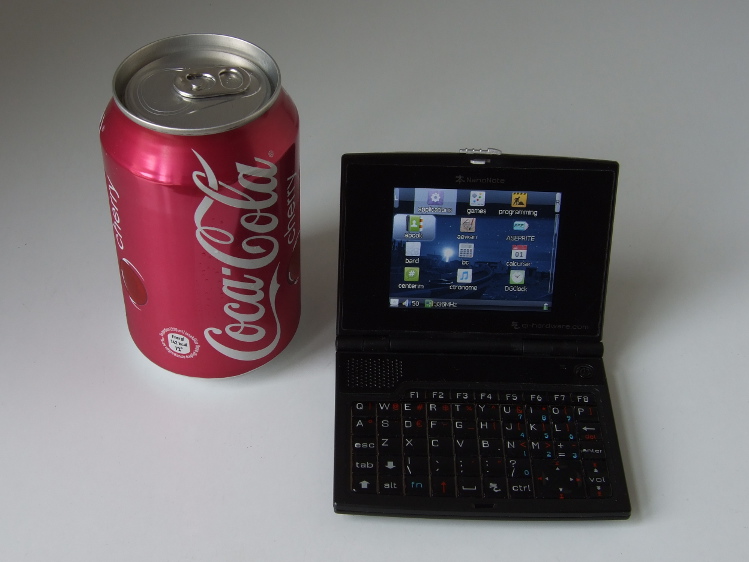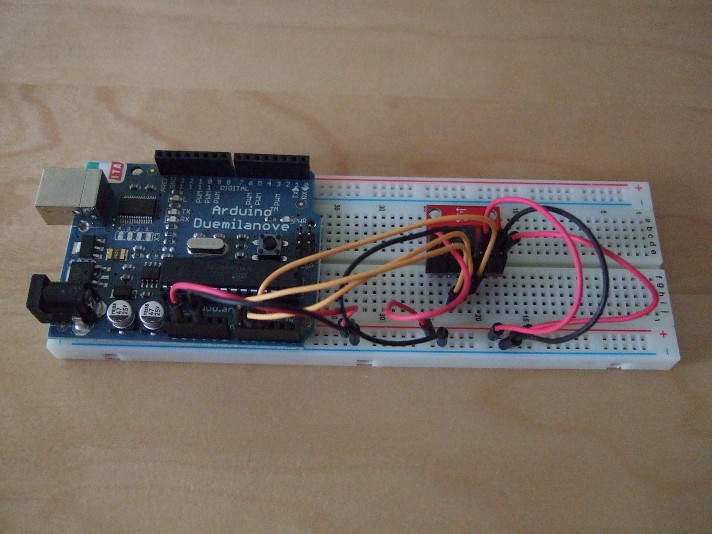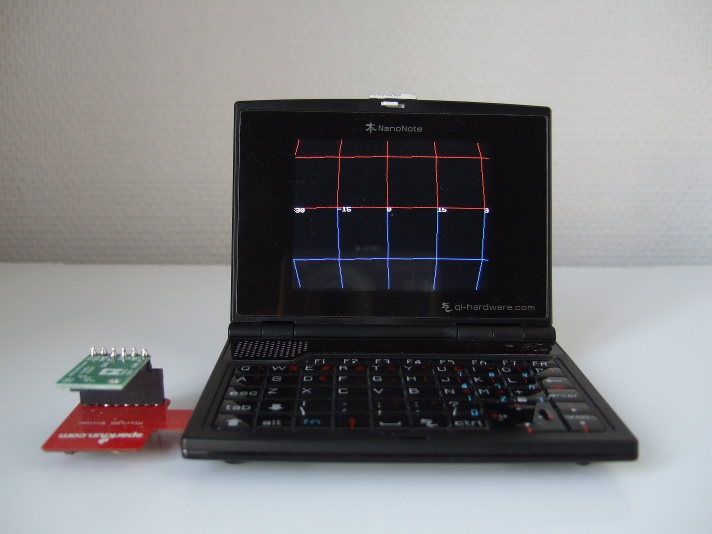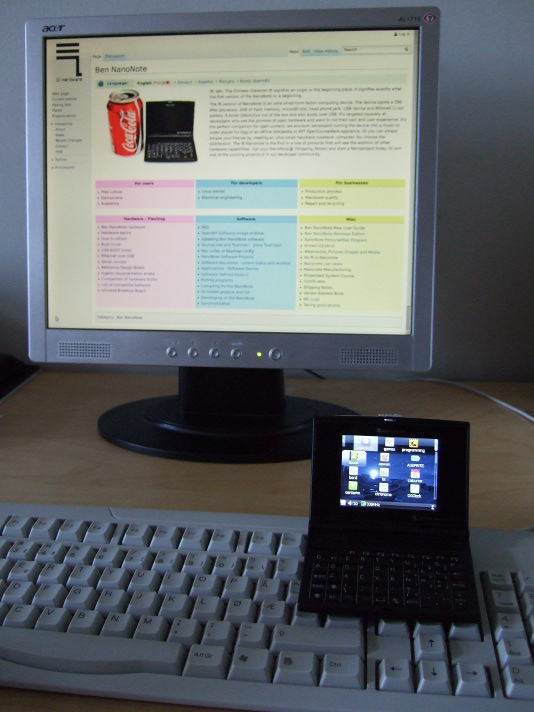The Organisational Panic Button and the Magic Single Vendor Delusion
Wednesday, November 27th, 2013I have had reason to consider the way organisations make technology choices in recent months, particularly where the public sector is concerned, and although my conclusions may not come as a surprise to some people, I think they sum up fairly well how bad decisions get made even if the intentions behind them are supposedly good ones. Approaching such matters from a technological point of view, being informed about things like interoperability, systems diversity, the way people adopt and use technology, and the details of how various technologies work, it can be easy to forget that decisions around acquisitions and strategies are often taken by people who have no appreciation of such things and no time or inclination to consider them either: as far as decision makers are concerned, such things are mere details that obscure the dramatic solution that shows them off as dynamic leaders getting things done.
Assuming the Position
So, assume for a moment that you are a decision-maker with decisions to make about technology, that you have in your organisation some problems that may or may not have technology as their root cause, and that because you claim to listen to what people in your organisation have to say about their workplace, you feel that clear and decisive measures are required to solve some of those problems. First of all, it is important to make sure that when people complain about something, they are not mixing that thing up with something else that really makes their life awkward, but let us assume that you and your advisers are aware of that issue and are good at getting to the heart of the real problem, whatever that may be. Next, people may ask for all sorts of things that they want but do not actually need – “an iPad in every meeting room, elevator and lavatory cubicle!” – and even if you also like the sound of such wild ideas, you also need to be able to restrain yourself and to acknowledge that it would simply be imprudent to indulge every whim of the workforce (or your own). After all, neither they nor you are royalty!
With distractions out of the way, you can now focus on the real problems. But remember: as an executive with no time for detail, the nuances of a supposedly technological problem – things like why people really struggle with some task in their workplace and what technical issues might be contributing to this discomfort – these things are distractions, too. As someone who has to decide a lot of things, you want short and simple summaries and to give short and simple remedies, delegating to other people to flesh out the details and to make things happen. People might try and get you to understand the detail, but you can always delegate the task of entertaining such explanations and representations to other people, naturally telling them not to waste too much time on executing the plan.
On the Wrong Foot
So, let us just consider what we now know (or at least suspect) about the behaviour of someone in an executive position who has an organisation-wide problem to solve. They need to demonstrate leadership, vision and intent, certainly: it is worth remembering that such positions are inherently political, and if there is anything we should all know about politics by now, it is that it is often far more attractive to make one’s mark, define one’s legacy, fulfil one’s vision, reserve one’s place in the history books than it is to just keep things running efficiently and smoothly and to keep people generally satisfied with their lot in life; this principle alone explains why the city of Oslo is so infatuated with prestige projects and wants to host the Winter Olympics in a few years’ time (presumably things like functioning public transport, education, healthcare, even an electoral process that does not almost deliberately disenfranchise entire groups of voters, will all be faultless by then). It is far more exciting being a politician if you can continually announce exciting things, leaving the non-visionary stuff to your staff.
Executives also like to keep things as uncluttered as possible, even if the very nature of a problem is complicated, and at their level in the organisation they want the explanations and the directives to be as simple as possible. Again, this probably explains the “rip it up and start over” mentality that one sees in government, especially after changes in government even if consecutive governments have ideological similarities: it is far better to be seen to be different and bold than to be associated with your discredited predecessors.
But what do these traits lead to? Well, let us return to an organisational problem with complicated technical underpinnings. Naturally, decision-makers at the highest levels will not want to be bored with the complications – at the classic “10000 foot” view, nothing should be allowed to encroach on the elegant clarity of the decision – and even the consideration of those complications may be discouraged amongst those tasked to implement the solution. Such complications may be regarded as a legacy of an untidy and unruly past that was not properly governed or supervised (and are thus mere symptoms of an underlying malaise that must be dealt with), and the need to consider them may draw time and resources away from an “urgently needed” solution that deals with the issue no matter what it takes.
How many times have we been told “not to spend too much time” on something? And yet, that thing may need to be treated thoroughly so that it does not recur over and over again. And as too many people have come to realise or experience, blame very often travels through delegation: people given a task to see through are often deprived of resources to do it adequately, but this will not shield them from recriminations and reprisals afterwards.
It should not demand too much imagination to realise that certain important things will be sacrificed or ignored within such a decision-making framework. Executives will seek simplistic solutions that almost favour an ignorance of the actual problem at hand. Meanwhile, the minions or underlings doing the work may seek to stay as close as possible to the exact word of the directive handed down to them from on high, abandoning any objective assessment of the problem domain, so as to be able to say if or when things go wrong that they were only following the instructions given to them, and that as everything falls to pieces it was the very nature of the vision that led to its demise rather than the work they did, or that they took the initiative to do something “unsanctioned” themselves.
The Magic Single Vendor Temptation
We can already see that an appreciation of the finer points of a problem will be an early casualty in the flawed framework described above, but when pressure also exists to “just do something” and when possible tendencies to “make one’s mark” lie just below the surface, decision-makers also do things like ignore the best advice available to them, choosing instead to just go over the heads of the people they employ to have opinions about matters of technology. Such antics are not uncommon: there must be thousands or even millions of people with the experience of seeing consultants breeze into their workplace and impart opinions about the work being done that are supposedly more accurate, insightful and valuable than the actual experiences of the people paid to do that very work. But sometimes hubris can get the better of the decision-maker to the extent that their own experiences are somehow more valid than those supposed experts on the payroll who cannot seem to make up their minds about something as mundane as which technology to use.
And so, the executive may be tempted to take a page from their own playbook: maybe they used a product in one of their previous organisations that had something to do with the problem area; maybe they know someone in their peer group who has an opinion on the topic; maybe they can also show that they “know about these things” by choosing such a product. And with so many areas of life now effectively remedied by going and buying a product that instantly eradicates any deficiency, need, shortcoming or desire, why would this not work for some organisational problem? “What do you mean ‘network provisioning problems’? I can get the Internet on my phone! Just tell everybody to do that!”
When the tendency to avoid complexity meets the apparent simplicity of consumerism (and of solutions encountered in their final form in the executive’s previous endeavours), the temptation to solve a problem at a single stroke or a single click of the “buy” button becomes great indeed. So what if everyone affected by the decision has different needs? The product will surely meet all those needs: the vendor will make sure of that. And if the vendor cannot deliver, then perhaps those people should reconsider their needs. “I’ve seen this product work perfectly elsewhere. Why do you people have to be so awkward?” After all, the vendor can work magic: the salespeople practically told us so!
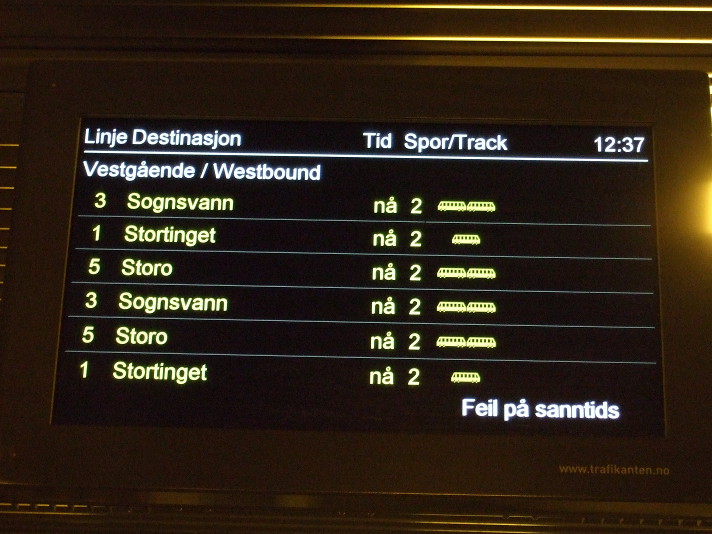
Nothing wrong here: a public transport "real time" system failure; all the trains are arriving "now"
The Threat to Diversity
In those courses in my computer science degree that dealt with the implementation of solutions at the organisational level, as opposed to the actual implementation of software, attempts were made to impress upon us students the need to consider the requirements of any given problem domain because any solution that neglects the realities of the problem domain will struggle with acceptance and flirt with failure. Thus, the impatient executive approach involving the single vendor and their magic product that “does it all” and “solves the problem” flirts openly and readily with failure.
Technological diversity within an organisation frequently exists for good reason, not to irritate decision-makers and their helpers, and the larger the organisation the larger the potential diversity to be found. Extrapolating from narrow experiences – insisting that a solution must be good enough for everyone because “it is good enough for my people” – risks neglecting the needs of large sections of an organisation and denying the benefits of diversity within the organisation. In turn, this risks the health of those parts of an organisation whose needs have now been ignored.
But diversity goes beyond what people happen to be using to do their job right now. By maintaining the basis for diversity within an organisation, it remains possible to retain the freedom for people to choose the most appropriate systems and platforms for their work. Conversely, undermining diversity by imposing a single vendor solution on everyone, especially when such solutions also neglect open standards and interoperability, threatens the ability for people to make choices central to their own work, and thus threatens the vitality of that work itself.
Stories abound of people in technical disciplines who “also had to have a Windows computer” to do administrative chores like fill out their expenses, hours, travel claims, and all the peripheral tasks in a workplace, even though they used a functioning workstation or other computer that would have been adequate to perform the same chores within a framework that might actually have upheld interoperability and choice. Who pays for all these extra computers, and who benefits from such redundancy? And when some bright spark in the administration suggests throwing away the “special” workstation, putting administrative chores above the real work, what damage does this do to the working environment, to productivity, and to the capabilities of the organisation?
Moreover, the threat to diversity is more serious than many people presumably understand. Any single vendor solution imposed across an organisation also threatens the independence of the institution when that solution also informs and dictates the terms under which other solutions are acquired and introduced. Any decision-maker who regards their “one product for everybody” solution as adequate in one area may find themselves supporting a “one vendor for everything” policy that infects every aspect of the organisation’s existence, especially if they are deluded enough to think that they getting a “good deal” by buying all their things from that one vendor and thus unquestioningly going along with it all for “economic reasons”. At that point, one has to wonder whether the organisation itself is in control of its own acquisitions, systems or strategies any longer.
Somebody Else’s Problem
People may find it hard to get worked up about the tools and systems their employer uses. Surely, they think, what people have chosen to run a part of the organisation is a matter only for those who work with that specific thing from one day to the next. When other people complain about such matters, it is easy to marginalise them and to accuse them of making trouble for the sake of doing so. But such reactions are short-sighted: when other people’s tools are being torn out and replaced by something less than desirable, bystanders may not feel any urgency to react or even think about showing any sympathy at all, but when tendencies exist to tackle other parts of an organisation with simplistic rationalisation exercises, who knows whose tools might be the next ones to be tampered with?
And from what we know from unfriendly solutions that shun interoperability and that prefer other solutions from the same vendor (or that vendor’s special partners), when one person’s tool or system gets the single vendor treatment, it is not necessarily only that person who will be affected: suddenly, other people who need to exchange information with that person may find themselves having to “upgrade” to a different set of tools that are now required for them just to be able to continue that exchange. One person’s loss of control may mean that many people lose control of their working environment, too. The domino effect that follows may result in an organisation transformed for the worse based only on the uninformed gut instincts of someone with the power to demand that something be done the apparently easy way.

Inconvenience: a crane operating over one pavement while sitting on the other, with a sign reading "please use the pavement on the other side"
Getting the Message Across
For those of us who want to see Free Software and open standards in organisations, the dangers of the top-down single vendor strategy are obvious, but other people may find it difficult to relate to the issues. There are, however, analogies that can be illustrative, and as I perused a publication related to my former employer I came across an interesting complaint that happens to nicely complement an analogy I had been considering for a while. The complaint in question is about some supplier management software that insists that bank account numbers can only have 18 digits at most, but this fails to consider the situation where payments to Russian and Chinese accounts might need account numbers with more than 18 digits, and the complainant vents his frustration at “the new super-elite of decision makers” who have decided that they know better than the people actually doing the work.
If that “super-elite” were to call all the shots, their solution would surely involve making everyone get an account with an account number that could only ever have 18 digits. “Not supported by your bank? Change bank! Not supported in your country? Change your banking country!” They might not stop there, either: why not just insist on everyone having an account at just one organisation-mandated bank? “Who cares if you don’t want a customer relationship with another bank? You want to get paid, don’t you?”
At one former employer of mine, setting up a special account at a particular bank was actually how things were done, but ignoring peculiarities related to the nature of certain kinds of institutions, making everyone needlessly conform through some dubiously justified, executive-imposed initiative whether it be requiring them to have an account with the organisation’s bank, or requiring them to use only certain vendor-sanctioned software (and as a consequence requiring them to buy certain vendor-sanctioned products so that they may have a chance of using them at work or to interact with their workplace from home) is an imposition too far. Rationalisation is a powerful argument for shaking things up, but it is often used by those who do not care how much it manages to transfer the inconvenience in an organisation to the individual and to other parties.
Bearing the Costs
We have seen how the organisational cost of short-sighted, buy-and-forget decision-making can end up being borne by those whose interests have been ignored or marginalised “for the good of the organisation”, and we can see how this can very easily impose costs across the whole organisation, too. But another aspect of this way of deciding things can also be costly: in the hurry to demonstrate the banishment of an organisational problem with a flourish, incremental solutions that might have dealt with the problem more effectively can become as marginalised as the influence of the people tasked with the job of seeing any eventual solution through. When people are loudly demanding improvements and solutions, an equally dramatic response probably does not involve reviewing the existing infrastructure, identifying areas that can provide significant improvement without significant inconvenience or significant additional costs, and committing to improve the existing solutions quietly and effectively.
Thus, when faced with disillusionment – that people may have decided for themselves that whatever it was that they did not like is now beyond redemption – decision-makers are apt to pander to such disillusionment by replacing any existing thing with something completely new. Especially if it reinforces their own blinkered view of an organisational problem or “confirms” what they “already know”, decision-makers may gladly embrace such dramatic acts as a demonstration of the resolve expected of a decisive leader as they stand to look good by visibly banishing the source of disillusionment. But when such pandering neglects relatively inexpensive, incremental improvements and instead incurs significant costs and disruptions for the organisation, one can justifiably question the motivations behind such dramatic acts and the level of competence brought to bear on resolving the original source of discomfort.
Mission Accomplished?
Thinking that putting down money with a single vendor will solve everybody’s problems, purging diversity from an organisation and stipulating the uniformity encouraged by that vendor, is an overly simplistic and even deluded approach to organisational change. Change in any organisation can be very expensive and must therefore be managed carefully. Change for the sake of change is therefore incredibly irresponsible. And change imposed to gratify the perception of change or progress, made on a superficial basis and incurring unnecessary and avoidable burdens within an organisation whilst risking that organisation’s independence and viability, is nothing other than indefensible.
Be wary of the “single vendor fixes it all” delusion, especially if all the signs point to a decision made at the highest levels of your organisation: it is the sign of the organisational panic button being pressed while someone declares “Mission Accomplished!” Because at the same time they will be thinking “We will have progress whatever the cost!” And you, not them, will be the one bearing the cost.



